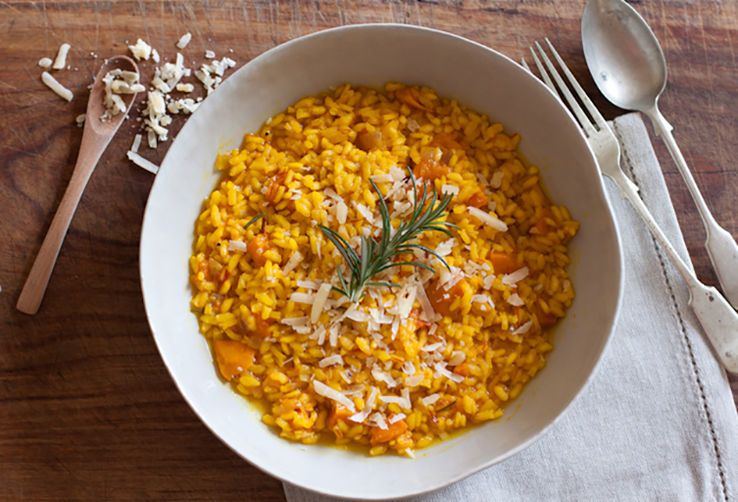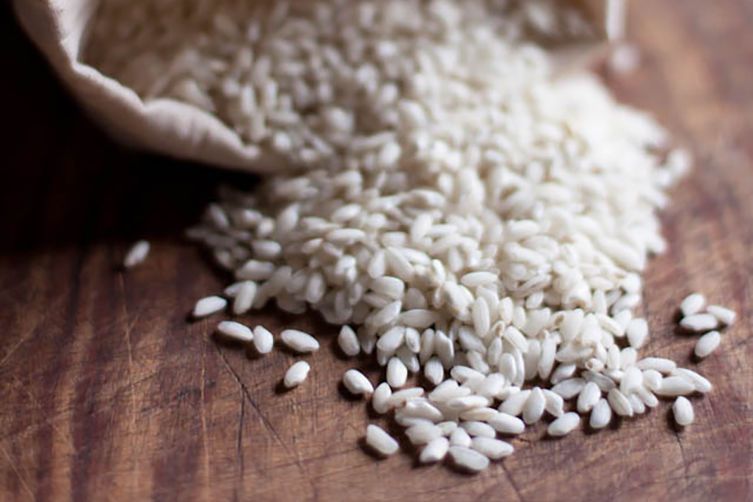Every Tuesday, Italian expat Emiko Davies is taking us on a grand tour of Italy, showing us how to make classic, fiercely regional dishes at home.
Today: A golden-hued risotto with creamy butternut squash, inspired by fall in Tuscany.

This delicate, golden-hued risotto with creamy butternut squash is autumn on a plate. It's inspired by a dish I've had many times at a farm in San Gimignano, Tuscany, that produces its own saffron -- painstakingly hand-picked every fall. Saffron has been grown in the hills around San Gimignano since the Middle Ages and is harvested in autumn by hand, flower by flower, thread by thread. Tuscan saffron is hard to come by outside of the region -- in any case, try to use saffron threads in this dish, rather than powder, for the best flavor.
Risotto is one of those dishes that is often misunderstood or mismade too easily. That's simple to remedy, however. A successful risotto is partly about timing, partly about using the right rice, and partly about recognizing the moment the dish is finished -- when it's not too dry, not too wet, but al onda, "like a wave," as they say in Italian.
More: Here's a trick for stretching saffron.
Elizabeth David wrote quite a bit about risotto in Italian Food, going to much effort to put right the ways of English readers and recipe writers who have long been using the wrong rice to make a true risotto. It is the rice that makes a risotto unique; it’s what gives it its all-important texture, consistency, and even its flavor -- especially in a risotto as simple as this one.

Arborio and Carnaroli are probably the most well-known types of risotto rice, but Vialone Nano is one of the best varieties for risotto. These short-grained, pearly rices are high in starch and create a creamy risotto while keeping their bite. There is nothing worse than an overcooked, mushy risotto, or a sticky one that you could shape into a castle. It should be at a consistency with enough creamy liquid to make the risotto “wave-like” -- when you wobble the dish or pan it should be loose and flatten out easily, not sit upright on the plate. A good cook knows when to remove the risotto from the heat in order to retain this ideal stage, keeping in mind that the rice will continue to cook in its own heat.
David mentioned two important points in her description of this risotto that are just as valid today as they would have been in 1956 when she wrote Italian Food: “In a good and conscientious restaurant, say in Milan or Venice or Turin, you must wait for your risotto just as in a French restaurant you would expect to wait for your soufflé.” A risotto takes about 17 minutes to cook. If you want a proper risotto, that’s how long you will need to wait for it.
More: Get to know rice, down to the grain.
She also wrote, “Don’t, by the way, look for good risotti in Florence and Tuscany. Tuscan cooks, at any rate in my experience, don’t know how to make a correct risotto any more than do French or English ones” -- which is perhaps only a little true. Go to the north, to Lombardy or particularly the Veneto, for the best risotto. They are the experts. But today, Tuscans have adopted risotto in a number of ways using their favorite seasonal ingredients and traditional flavors; you will often find something like this risotto on a trattoria menu come fall.

You could technically cook the squash any way you prefer with this -- roasting is my second favorite way to cook the squash for this dish, but you can boil it too. I personally like any excuse to have less washing up to do, so I like to cook the squash in the same pan as the risotto.
Butternut Squash and Saffron Risotto (Risotto alla Zucca e Zafferano)
Serves 4
1/2 pound (250 grams) peeled and diced butternut squash
4 tablespoons olive oil
Salt and pepper to taste
2 pints (1 liter) vegetable stock
A pinch (about 1/10 gram) of saffron threads
1 cup (250 milliliters) dry white wine
1 brown onion, chopped
11 ounces (320 grams) arborio, carnaroli or vialone nano rice
1 sprig fresh rosemary, leaves picked and finely chopped
2 tablespoons (30 grams) cold butter
Finely grated Parmesan cheese to serve
See the full recipe (and save and print it) here.
Photos by Emiko Davies




See what other Food52 readers are saying.